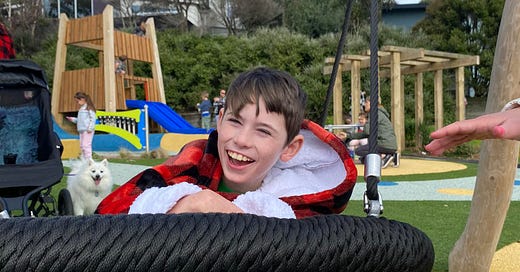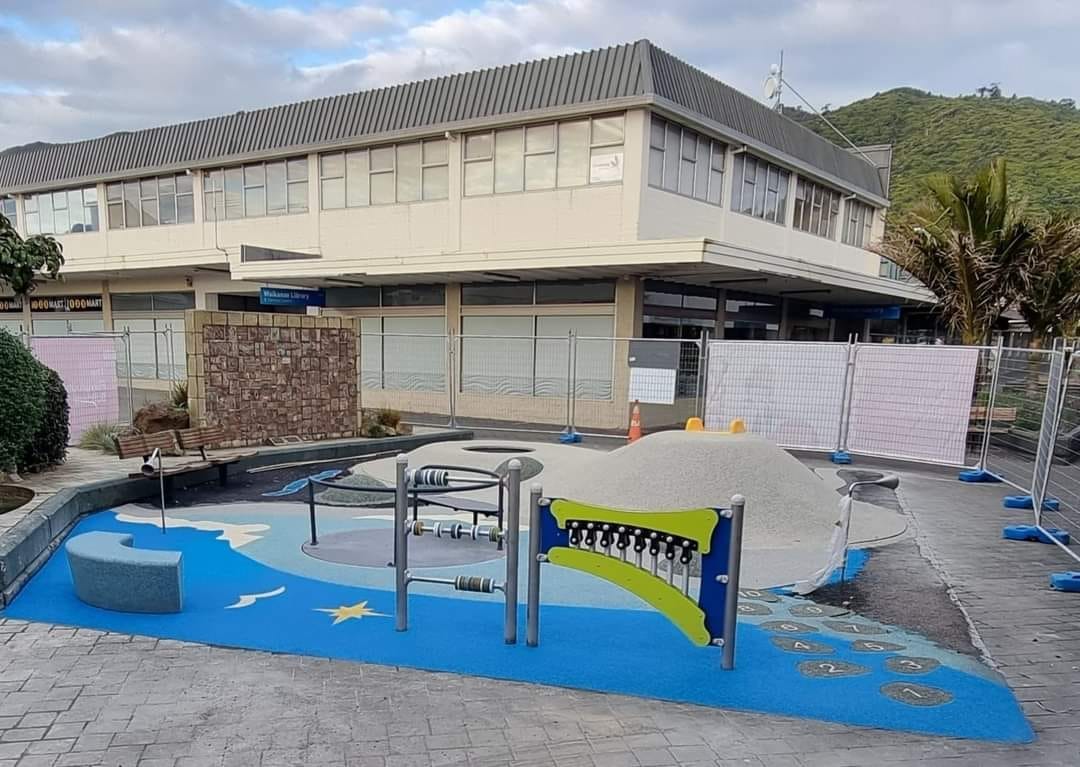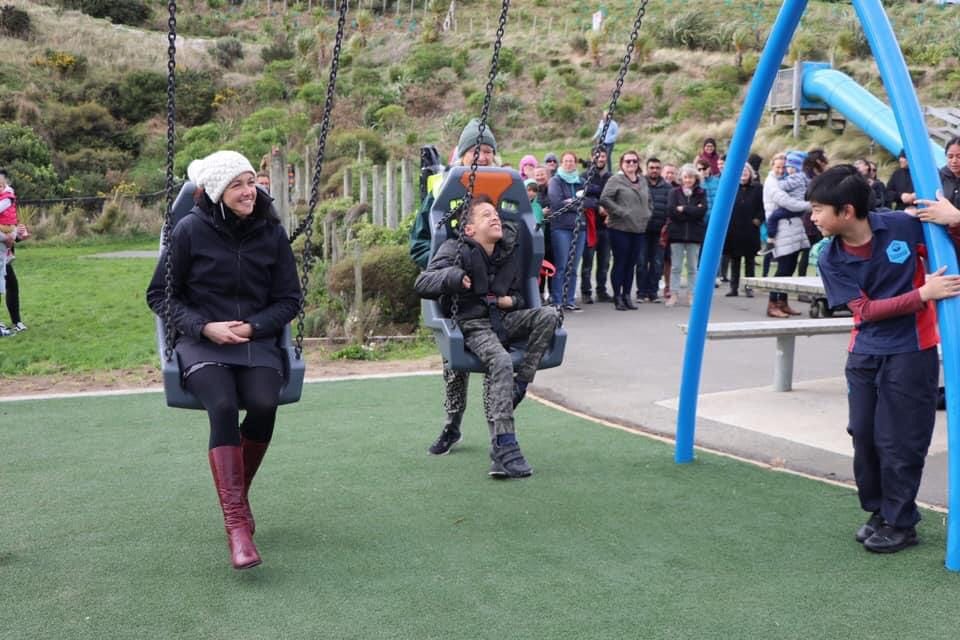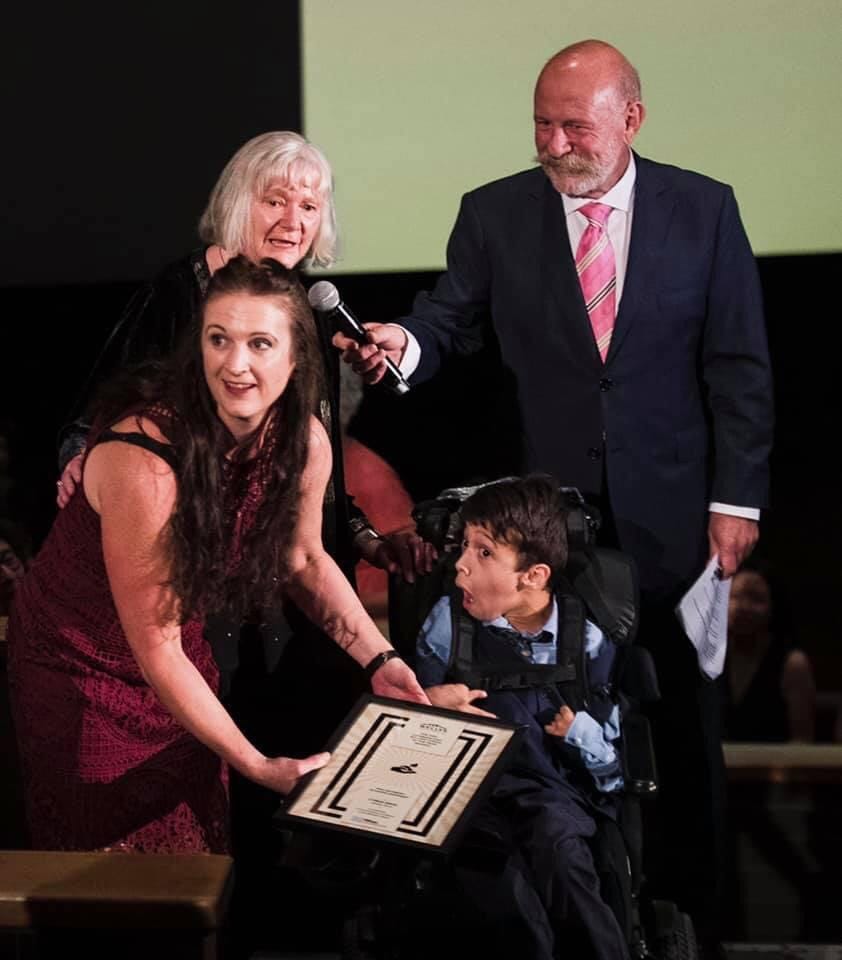“What is presented in front of me is a very depressing sight. Not a bright future.”
That was the prognosis from a paediatrician delivered to the parents of six month old Kash Edmonds, who has a rare form of Cerebral Palsy.
Fast forward ten years, this week Kash’s parents Nicola Stoddart-Edmonds and Dave Edmonds were accepting a civic award from Kapiti City District Council on his behalf, to acknowledge his contribution to the design and inspiration for the first (almost1) fully accessible playground in Kāpiti.
The Lorna Irene Drive Reserve Playground in Raumati South was “revamped” in 2022, and named NZ’s Playground of the Year in 2023.
It features NZ’s first wheelchair friendly seesaw, also an accessible roundabout, trampoline and tower. It also includes a specially designed and supportive bucket swing which was donated by Kris and Cyrus Dahl from Wellington.
Cyrus, 16, also has Cerebral Palsy. He fundraised over $43,000, for a swing in his local park and several others in the region.
Both Kash and Cyrus use AAC (Alternative & Augmentative Communication) to communicate, and were able to contribute to the design of their inclusive playground features. Cyrus has gone on to win the 2020 Wellingtonian of the Year Youth Philanthropist Award.
Perhaps the mistake councils make is that they choose to assume what disabled people want in a public space. Young people in particular, have been excluded from playgrounds for too long. Maybe we should start listening to our disabled rangatahi and let them lead the conversation, rather than presuming their needs on their behalf.
“The saddest playground ever” according to boomers
A day after celebrating with the Edmonds’ at the KCDC Good Sorts & Wellington Airport Community Awards earlier this week, I spotted a post in a local Facebook community group. There were two pictures of the Mahara Place (Waikanae) playground upgrade, the upgrade still in progress. Locals were asked of their opinion on the features of the new play area, and the responses were not particularly supportive. One commenter stating “it looks a bit crap, eh.”
Despite the fact it is clearly not a completed project, and features some lovely sensory activities, a wheelchair friendly surface, roundabout and trampoline - the consensus was a very clear MEH from the commenters.
“Saddest playground ever,” “a waste of ratepayers money",” “underwhelming & uninspiring,” “a ‘wish’ website upgrade,” “council should have gone to Specsavers” were a few of my personal faves.
The old playground was no longer fit for purpose and was “rotting” in places according to one local - but ok! Why change things for the better when the old version is still hanging in there by a (rusty) hook!?
Despite the fact KCDC advertises widely their upgrades of public spaces like playgrounds, sharing timelines, opportunity to contribute to the design in a variety of accessible formats, some commenters thought that council had independently decided what children want in a playground and designed it without outside input. The Lorna Irene playground is testament to the fact that KCDC at least is open to contribution from families with additional physical and sensory needs. Which is lucky, because I am on a personal crusade to make this rohe fully accessible and welcoming to people of all ages, mobility & communication styles, and abilities 😂
“That’s not for you” - when play isn’t for everyone
Even the most bitter of boomer commenter must recall the unbridled joy being a child, playing with friends at the local playground for hours on end. I wonder if they remember standing on the edge of the playground and knowing there is nothing for them there? Probably not. Thats why social media comments like those criticising Mahara Place are a kick in the guts to families like the Edmonds’ and the Dahl’s, who have experienced far too often the sting of being excluded from a public space that does not cater for wheelchairs, walkers, or any physical disability.
One of the great joys of parenthood is taking your child to play at a park - pushing them on a swing, climbing and swinging from jungle gyms, exploring and testing boundaries, getting sensory input from physical play. But what if your child can’t swing, climb or run?
What if your neurodivergent child struggles with open spaces and craves physical boundaries like fences to feel safe and secure? What if your child does not speak and requires visual supports to communicate in busy areas like playgrounds? What if your child likes to run and has no sense of danger? Or if on the border of the playground is a pond, and your child is drawn to water, with no care of their personal safety? How do you as their carer navigate playgrounds when your child is out of your line of vision?
Āue if I had $1 for every time I have hit my head or been clotheslined by a low hanging rope bridge while I’ve been scrambling to keep sight of my autistic daughter in a playground, I’d be rich💰
My point is, if you have never experienced these situations, if you’ve never had to tell your child “sorry sweetheart, this playground is not for you,” and have had to leave - then you need to own and acknowledge your privilege.
Families like the Edmonds’ and Dahl’s have supported their child’s right to play in their local playground, alongside their siblings and their peers, just like any other young person, disabled or not.
Appearing in a 2021 episode of Attitude, Cyrus said: “I have never wanted to go to parks before. It was boring watching all the other kids play. Now I want to go all the time.”
Kash and Cyrus have used their voice to tell their local council exactly what they want in a playground, and have put a wedge in the door to make sure that ALL rangatahi coming through can speak their truth and be heard by decision makers, to empower them to be active, full participants in their community.
Te Wero/The Challenge:
Are you listening to disabled rangatahi?
Are you listening to whanau who have been left on the outskirts of playgrounds looking longingly at public spaces that they can’t use?
Do you call yourself an ally to someone who has additional physical, intellectual, health or sensory needs?
Do you think about the needs of everyone, not the wants of a select few?
If you answered NO to any of these statements, do yourself a favour and talk to families in your community (there are plenty of us) and be open to learning about the accessible features that can be integrated into every public space to make your community a welcoming place for everyone who lives and visits here.
On a seat near an accessible swing in Cyrus’ local park is a plaque dedicated to Cyrus and his supporters. It reads: “Mā tatou te takaro - Play is for all.” Tautoko!!!
Dave and Nicola Edmonds could have accepted that paediatricians prognosis, and began a journey much different to the path they are travelling on. Kash is a joyful, brilliant, confident communicator - and now an award winning playground designer!
As Nicola told the audience at the awards ceremony, “no diagnosis can ever predict your child’s future.”
The future is VERY BRIGHT for Kash and Cyrus. We all can’t wait to see what you achieve next 💜
Almost = A bilingual core board/communication board will be installed in the foreseeable future 🎉








So well written! As a child going to the playground with my sister who was in a wheelchair, I would feel so sad that she couldn’t join in. Now seeing the MASSIVE progress in local parks, I just wish we could have experienced these together as children. Now, other kids do, and it’s awesome to see. So proud of Kash and all the work he put into his park, huge achievement for him and his family, what’s next! The world is his oyster